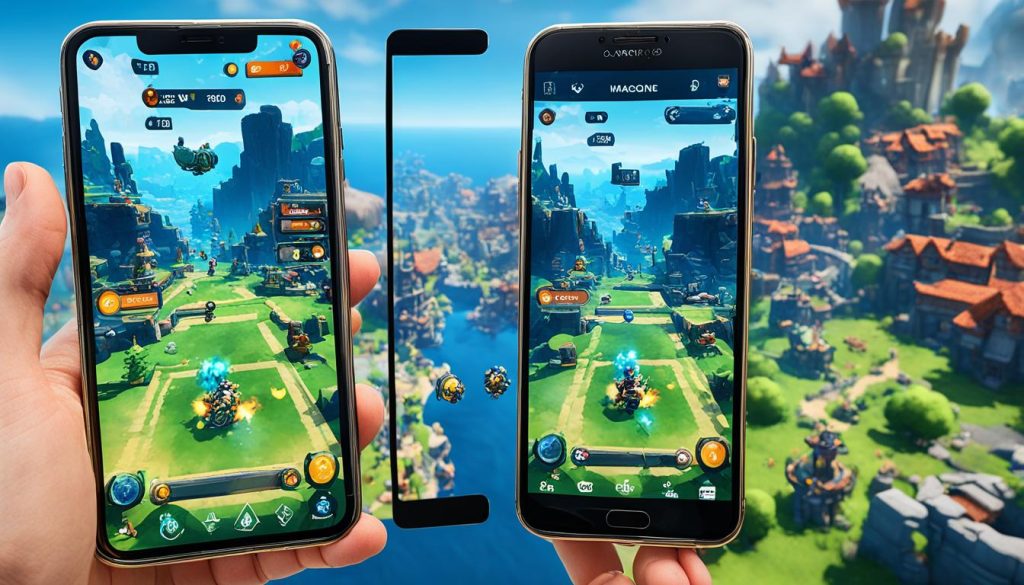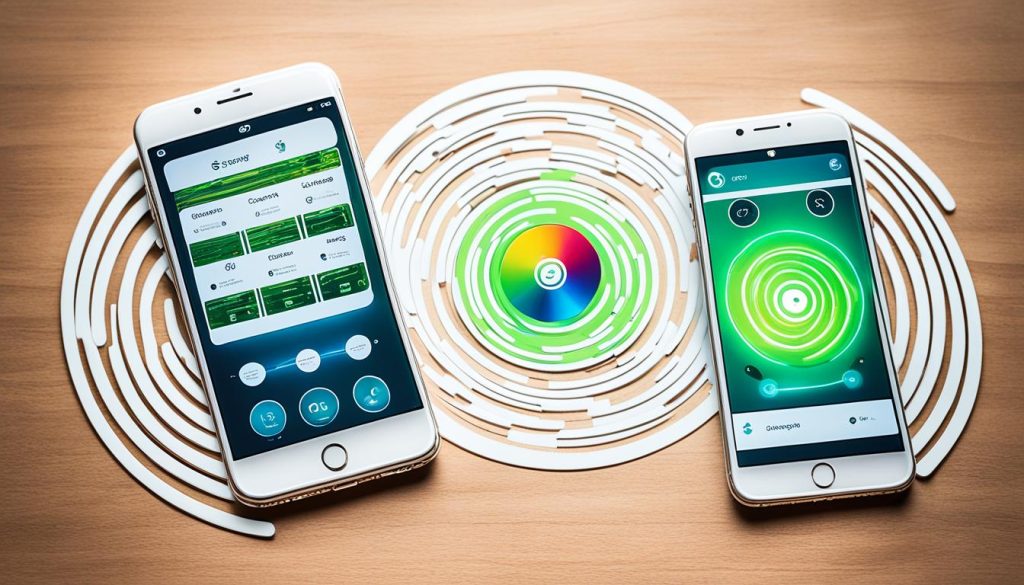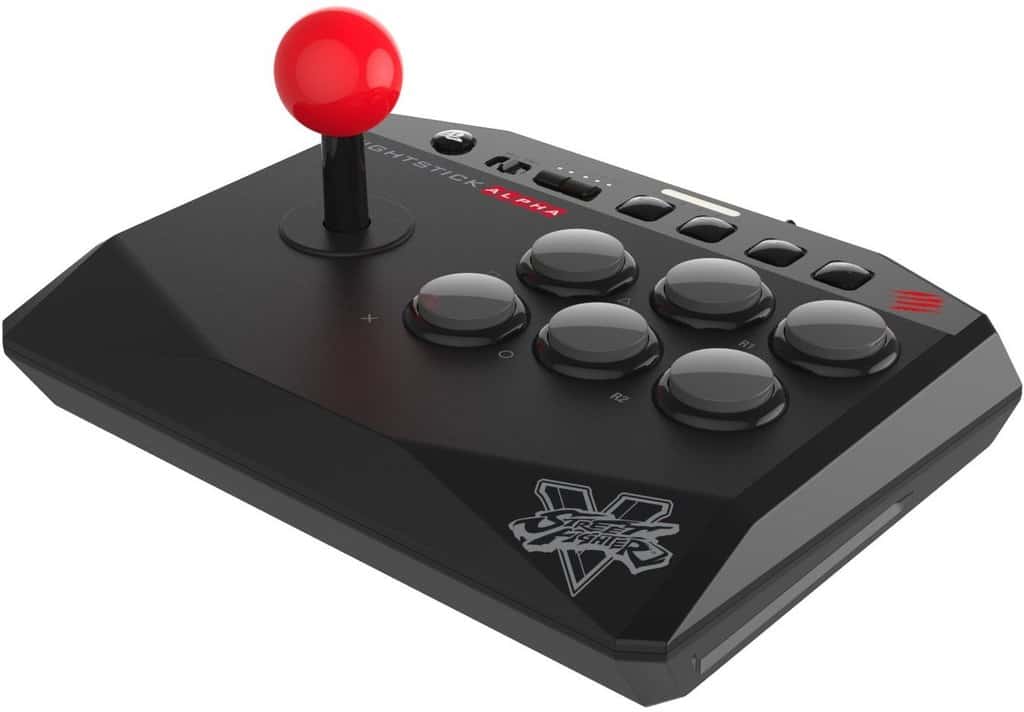Game On: The Ultimate Showdown Between iPhone and Android Gaming
When it comes to mobile gaming, the battle between iPhone and Android is fierce. Both platforms boast a wide array of games and loyal fanbases, but which one truly reigns supreme in the gaming arena? Is it the smooth performance of an iPhone or the versatility of an Android device that takes the crown? Let’s explore the pros and cons of each platform and settle the debate once and for all.
Content

- Optimization plays a crucial role in gaming performance, and iPhones have a clear advantage in this aspect due to their seamless hardware-software integration.
- When it comes to gyroscope performance, iPhones shine with their more responsive and faster sensors, providing a better gaming experience.
- When it comes to bullet registration, opinions vary, but iPhones are often regarded as having better registration, thanks to their optimization and hardware-software integration.
- The touch sampling rate may be higher on some Android devices, but iPhones still register touch input faster due to their optimization and hardware-software integration.
- While some players claim iPhones have less recoil, a side-by-side comparison shows no noticeable difference with Android devices.
- In the end, the choice between iPhone and Android for gaming comes down to personal preference and budget, with iPhones offering superior optimization and overall gaming experience, but Android devices providing wider affordability options and, in some cases, higher frame rates.
Optimization Comparison: iPhone vs Android
When it comes to optimization, iPhones have always had an edge over Android devices. The seamless hardware-software integration in iPhones ensures smooth performance and efficient resource allocation. Even older iPhone models, like the iPhone 11, can compete with the latest Android flagships in terms of gaming performance.
On the other hand, Android devices face optimization challenges due to the fragmented nature of the platform. With thousands of different devices on the market, it becomes a daunting task for game developers to optimize their games for every Android phone.
Gyroscope Comparison: iPhone vs Android
The gyroscope is an essential component for mobile gaming, especially for first-person shooter games. It plays a crucial role in providing accurate motion sensing and enhancing the overall gaming experience. When it comes to gyroscope sensors, iPhones have a clear advantage over Android devices.
iPhones’ gyroscope sensors are more responsive and faster, giving users a better gaming experience. The gyroscope delay in iPhones is minimal and hardly noticeable, ensuring smooth and precise movement tracking. This allows players to aim and control their in-game movements with precision and accuracy.
On the other hand, some Android devices experience delay or even the opposite direction movement when the device is in unusual positions. This can negatively impact the gameplay, especially in fast-paced and competitive games where split-second reactions matter.
With responsive and faster gyroscope sensors, iPhone users have an advantage when it comes to quick and accurate aiming, making it easier to stay competitive in intense gaming situations.
Overall, the gyroscope performance on iPhones is superior to that of Android devices, offering a more immersive and precise gaming experience.

Stay tuned for the next section of our article, where we dive into the bullet registration performance on iPhone and Android devices.
Bullet Registration: iPhone vs Android
Bullet registration is a critical aspect of first-person shooter games, where every shot can make a difference. When comparing the bullet registration performance between iPhones and Android devices, many players argue that iPhones tend to have better bullet registration.
This advantage could be attributed to the optimization and hardware-software integration in iPhones. The seamless integration between the hardware and software in iPhones ensures that the device can accurately register bullet hits, resulting in a smoother and more satisfying gameplay experience.
However, it’s important to note that bullet registration can also be influenced by other factors, particularly the player’s internet connection. Since online gaming heavily relies on a stable and fast internet connection, the overall bullet registration experience can vary based on the player’s network quality.
Therefore, it is challenging to make a definitive conclusion regarding the superiority of bullet registration between iPhones and Android devices. While iPhones may have an advantage in terms of optimization and hardware-software integration, the overall performance can still be influenced by external factors.
Check out how to turn sos off on iphone
Touch Sampling Rate: iPhone vs Android
When it comes to mobile gaming, touch responsiveness plays a crucial role in providing an immersive experience. Touch sampling rate, which determines how quickly a device registers touch input from the user, is an important factor to consider. Surprisingly, iPhones have a lower touch sampling rate compared to some Android devices. For example, the iPhone 11 features a touch sampling rate of 120Hz, while the OnePlus 9 Pro boasts a higher touch sampling rate of 240Hz to 360Hz. However, the touch sampling rate alone does not determine the overall touch responsiveness of a device.
Despite the higher touch sampling rate on Android devices, iPhones still manage to register touch input faster due to their optimization and hardware-software integration. These factors contribute to a seamless and lag-free touch response on iPhones, allowing gamers to enjoy smoother gameplay. The combination of optimization and hardware-software integration ensures that touch inputs are accurately and swiftly translated into in-game actions.
It’s important to note that touch sampling rate is just one aspect of touch responsiveness, and it should be considered in conjunction with other factors like optimization, hardware-software integration, and the game’s overall performance on the device. While Android devices may have a higher touch sampling rate, the overall user experience may vary depending on how well the device optimizes touch inputs for gaming.
The optimization and hardware-software integration in iPhones contribute to their fast and accurate touch response, despite having a lower touch sampling rate compared to some Android devices.
- While iPhones have a lower touch sampling rate, their optimization and hardware-software integration optimize touch responsiveness for gaming.
- Android devices may boast higher touch sampling rates, but the overall touch performance relies on factors such as optimization and hardware-software integration.
- Touch sampling rate is just one factor to consider when evaluating touch responsiveness for gaming. The overall gaming experience depends on various factors and should not be solely based on touch sampling rate.
Recoil Control: iPhone vs Android
Recoil control is a crucial aspect of gaming that directly impacts shooting accuracy. Some players argue that iPhones have an advantage over Android devices when it comes to recoil control. They attribute this to the superior gyro and touch response of iPhones. However, when we compare the recoil patterns side by side, there is no noticeable difference between Android and iPhone devices.
The gyroscope and touch response in iPhones may make it easier for players to control recoil, but the actual recoil pattern remains the same on both platforms. Whether you’re playing on an iPhone or an Android device, you will experience similar recoil dynamics within the game.
It’s important to note that the ability to control recoil effectively depends more on personal skill and technique rather than the device itself. Experienced players can achieve remarkable recoil control regardless of the platform they choose. While iPhones offer superior gyro and touch response, players can still master recoil control on Android devices with practice and skill.
Ultimately, when it comes to recoil control, there is no significant advantage of one platform over the other. Both iPhone and Android devices provide a capable gaming experience without any noticeable difference in recoil control.
Conclusion
After a thorough examination of iPhone and Android devices for gaming, it is clear that iPhones have a slight edge over their Android counterparts. The superior optimization of iPhones guarantees a smooth gaming experience, with efficient resource allocation and seamless hardware-software integration. This level of optimization allows even older iPhone models to compete with the latest Android flagships in terms of gaming performance.
In addition to optimization, iPhones also excel in gyroscope performance and touch response. The gyroscope sensors in iPhones are more responsive and faster, providing users with a better gaming experience, especially for first-person shooter games. Additionally, despite having a lower touch sampling rate compared to some Android devices, iPhones register touch input faster, thanks to their exceptional optimization and hardware-software integration.
Furthermore, iPhones offer excellent frame rate stability and graphics quality, contributing to an immersive gaming experience. However, it is important to note that Android devices provide wider affordability options and, in some cases, higher frame rates. When choosing between iPhone and Android for gaming, it ultimately comes down to personal preference and budget.
In summary, iPhone users can expect a superior gaming experience with their devices. The combination of superior optimization, gyroscope performance, touch response, frame rate stability, and graphics quality makes iPhones the preferred choice for gaming enthusiasts. Nevertheless, Android devices offer their own advantages, such as affordability and potential higher frame rates, making them a viable option for gamers on a budget. Ultimately, the decision between iPhone and Android for gaming hinges on individual preferences and financial considerations.
FAQ
How does the optimization compare between iPhones and Android devices for gaming?
iPhones have the edge when it comes to optimization, thanks to their seamless hardware-software integration. Android devices face challenges due to the fragmented nature of the platform.
Do iPhones have a better gyroscope performance compared to Android devices?
Yes, iPhones have a clear advantage in gyroscope performance. Their sensors are more responsive and faster, providing a better gaming experience.
Are there any differences in bullet registration between iPhones and Android devices for gaming?
Some players claim that iPhones have better bullet registration, which could be attributed to their optimization and hardware-software integration. However, bullet registration also depends on the player’s internet connection.
How do the touch sampling rates compare between iPhones and Android devices?
Surprisingly, some Android devices have higher touch sampling rates than iPhones. However, iPhones still register touch input faster due to their optimization and hardware-software integration.
Is there a noticeable difference in recoil control between iPhones and Android devices?
While the gyro and touch response in iPhones may make it easier for players to control recoil, there is no noticeable difference in the actual recoil patterns between the two platforms.






